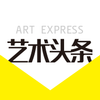分享到微信,
请点击右上角。
再选择[发送朋友]
或[分享到朋友圈]

1. Born in Tianjin, Zhang Yu is a contemporary Chinese Artist who received formal arts education. “Experimental Ink Painting”, which he began to advocate since the early 1990's, is now a mature artistic movement. Within the rise of this art movement, he is considered a flag bearer of sorts. He has not only received attention from various parts of China, but also aroused intense debates in this field while at the same time garnering international recognition. He has been invited to exhibit all over the world as he has actively broadened the domain of ink painting.
The year 2008 saw Zhang Yu’s first invitation to exhibit in Taiwan. Since then he has begun to infuse the Taiwanese art scene with the concept of “Experimental Ink Painting”. Besides exhibiting his creations through holding solo shows, he also participated in introducing the concept of Chinese experimental ink painting to Taiwan through group shows. These shows have become an additional point of reference for the development of Taiwanese ink painting even though they have only begun just recently.
Zhang Yu is a clear headed artist who is courageous and willing to put his beliefs to practice. In his creative process, Zhang Yu plays the role of an experimental ink painter, but if we try to interpret his role from the standpoint of Taiwanese art, we shall discover that this context is interpreted differently between the two sides of the Taiwan strait within the past half century or so; especially regarding the medium of ink within the context of art, Taiwan and the mainland in reality are two different stages. Thus, from Tianjin to Taipei he is faced with a dissimilar textual history, actions, ideas, as well as languages in art.
In Zhang Yu’s experimental ink painting we can see that mainland China was confronted by the “post eighty-nine” contemporary art that was full of sarcasm which emerged in the 90’s. Prior to the rise of Chinese modern art, ink painting lingered under the shadows of Revolutionary art. On the other hand, we see in Taiwan the dominance and assimilation of modern art of the 21st century that spans multiple media in its production. That is to say that ink painting faced challenges posted by modern art prior to the flowering of Taiwanese modern art.
These are the issues we must clarify in order to see clearly who Zhang Yu is, what the significance of his appearance in Taipei is, and what the relationship is between him and Chinese ink painting. Additionally, we must also clarify how ink painting is interpreted by the Taiwanese society, and how Zhang Yu is viewed within this society.
2. Zhang Yu was born in Tianjin in 1959. He is of a generation that endured hardship during the Cultural Revolution. During this period he lived a life of a reformed laborer with his parents in the countryside. It is safe to say that he recognizes the value of manual labor and maybe this period of labor contributed to the realization of his art practice in the days to come, which allowed him to nurture the “fingerprint" works that are full of repetitive motion.
Zhang Yu had to work as he studied when he was growing up in this turbulent environment. He was accepted into the Yangliuqing Painting Club through examination upon graduating from high school, and from there began his career as an apprentice. In 1981, when he was 22 years of age, he was accepted by the Central Academy of Fine Arts, however this acceptance was not approved by his work unit and as a result he had to abandon further schooling. This decision destined Zhang Yu to become an artist outside of academia. In retrospect, judging by the results of his developmental process outside of the institution, contrary to expectations, this allowed him to forego much baggage that comes with this learning. Particularly in the management of his ink painting career, he was no longer confined by the paintings of neither literati, nor Revolutionary Art within the academia.
Zhang Yu was not always in opposition to traditional ink painting throughout the course of his career. Rather, he latently groped about for the essence of ink painting itself. We can see his exceedingly sturdy roots in ink painting through his works such as the “Fan Painting Series” (1984-1989), “Portrait Series” (1987-1991), and continuing on to the “Random thoughts Collection” in 1993.
The beginning of the 90's saw a China that entered the age of reconstruction as it began a process of reform by opening its doors to the outside world. Modern art in China also germinated during this period. It is during this time that Zhang Yu also began to reveal his studious preponderance in a rigorously daring way through his work. We can see through “Notes on Ink Images” (1992-1994) and the “Divine Light Series” (1994-2003) that he began to veer towards the modern in ink painting. Within his divergence, Zhang Yu relied on the inner spirit of ink painting – rather than a transplanted artistic trend originating from abroad – to create his work. Although he started to look into the modern in ink painting since 1989, as evident in his editorial work on the book titled “Modern Chinese Ink Painting”, it was not until 1993 that he formally announced this new artistic intention called “experimental ink painting” in his editorial work on the book titled “Trends of Modern Chinese Ink Works at the End of the Twentieth Century".
This declaration indicates that he wanted to establish a new position for experimental ink painting within the domain of Chinese contemporary art during that time. In this writing “Ink and Wash is a Kind of Spirit: The Art-Historical Significance of Contemporary Experimental Ink and Wash and the Characteristics of Its Language” (2006), Zhang Yu pointed out that although this wave of Chinese contemporary art arrived like an avalanche in the 80’s, this current did not bring about a deeper appreciation for ink works. It is this sentiment for ink works that gave him the conviction to initiate the experimental ink painting movement.
3. As for “experimental ink work”, Zhang Yu asserted in 1999 in a writing titled “Manifesto of Experimental Ink and Wash” penned by him: “Experimental ink work opposes an ideology centered on pen and ink, it wishes to distance itself from the standards set for ink works under the literati tradition to the point of a fracture. It is a newly paved path outside the system of this literati tradition.” This declaration further emphasized that: “Experimental ink work falls under a non-representational schema and image. It is not simply an abstraction in the fashion of Western abstract art, and it is not directly related to the system of abstract drawing that uses dots, lines and planes in its structure.”
We shall discover from this assertion that Zhang Yu is a torrentially eloquent philosopher as well as an artist who practices what he preaches. The “Fingerprints” series which he has brought to the public is his personal creative realization of this experimental ink work. When viewed from the perspective of this experimental movement, the significance and the qualities of his “Fingerprints” series becomes readily apparent. “Fingerprints” is not only the creative language of an artist; it is also a record of action within an artistic movement. According to Zhang Yu’s own words, he had already begun intermittently to create “Fingerprints” in 1991, and since 2002 this work has never ceased. To date, this series has extended its reach to include different media, space, and exhibitive activities in the production of its work.
Since the publication of this series of work, whether Zhang Yu and the movement that he led has shaken up the faction that is of the traditional Chinese ink work, whether this concept has found acceptance by them, or if there is even a dialogue that has been generated have become irrelevant questions; because the reality is ever present in front of us, and the vigorous development of this movement is to be seen in many corners throughout China. Also, the international attention he has garnered since the 90’s has given him a unique identity outside of the world of traditional ink painting. In other words, this movement is no longer trying to convince lovers of traditional ink work, rather it has forged ahead to establish its own artistic language and cultivate its own enthusiasts. In the post “eighty-nine” world of modern art in China, this movement has opened up a domain that is wholly its own, it is no longer concerned with traditional ink work that is hemmed in between Revolutionary work and Contemporary art. It now marches to the beat of its own drum.
4. The appearance of the “Fingerprints” series in Taipei confronts a different issue in the art of ink work. Although the number of people engaged in ink painting is not many in comparison to mainland China, the history and the development of this art form in Taiwan is relatively more complex.
Ink work in the literati tradition has been passed onto Taiwan since the Qing, or even late Ming dynasty. This tradition saw a gradual decline during Japanese occupation, and following that, Western oil painting came to replace Japanese Oriental paintings. It was not until the arrival of the republic government in Taiwan, this literati tradition of ink painting returned to Taiwan. The revival of this genre is thanks in no small part to its vigorous promotion by the republic government. However, this amputation by the Japanese colonial government followed by the support of the republic government placed the art of ink works in between political policies, unable to find its autonomous status, and once the circumstances solidified it had rested in the domain of conservatism.
It was not until the late 50’s and the early 60’s, during the rise of contemporary art, that we began to hear voices of criticism and doubt with regard to this literati tradition in ink work. The representative of this voice at that time was Liu Guosong, who intermittently represented the current of abstract art within “Tong Fang Art Association”.
In other words, throughout the various colonial pasts in this land from Japanese amputation to republic revival, the validity of the cultural importance of ink work has always been called into question. Once the literati tradition established itself as being synonymous with ink painting, it was then challenged by modern art. This challenge which began in the 60's became the dawning of modern ink work in Taiwan. The call to ‘'revolutionize mediocrity” offered by Liu Guosong paved a very similar new beginning to the works of Zhang Yu. We should however point out that while Liu Guosong is an established master within modern ink painting, his earlier courageous voice was a solitary one. This leads us to ponder whether Zhang Yu’s work will also be left in solitary silence.
5. This past decade has moved the Taiwanese art scene into a position of reverence for conceptual art and the use of multimedia. This puts ink work, and other media at an unfavorable position. Zhang Yu's arrival in Taiwan at this moment makes us wonder whether his work will also fall into this predicament and find itself unable to breath. Or perhaps, his work that is infused with the qualities of conceptual art will find an opportunity to thrive. Maybe this is a difficult question to infer, but within the current artistic environment in Taiwan, which is full of prejudice towards different media of production, perchance, Zhang Yu’s work is a cut above the rest for the reason that it makes prominent the toil of the artist.
By Liao Renyi
(Taipei National University of the Arts, Professor at the Graduate Institute of Museum Studies)

分享到微信,
请点击右上角。
再选择[发送朋友]
或[分享到朋友圈]

